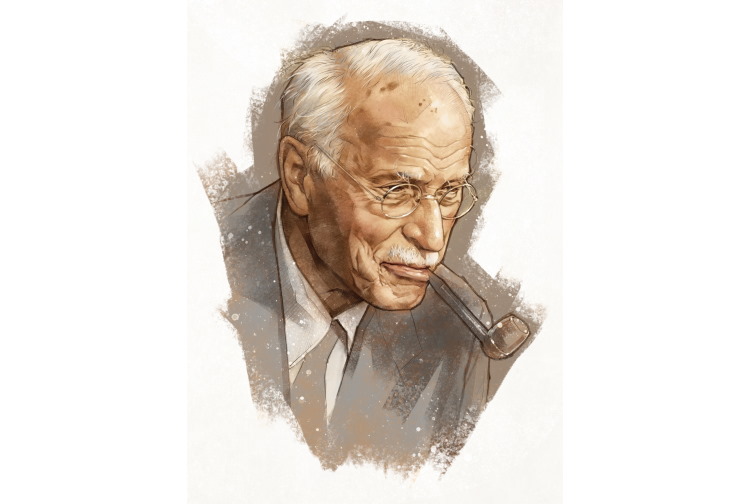Shadow Work: How To Confront Your Hidden Dark Side

So, let’s get started with shadow work.
Nice and easy.
We’ll break it all down.
First of all, you’re going to need to know what your ‘shadow’ is before you can start working on it!
What Is The Shadow?
The shadow is a concept born out of Jungian psychology.
Carl Gustav Jung was a philosopher, scientist and the founding father of analytical psychology. Born in 1875 and dying in 1961, he is one of the biggest contributors to our current understanding of dreams and the human psyche.
Starting in around 1919, Carl first coined the term ‘archetypes’.
I’ll explain what an archetype is.
Because you’ll need to know this before you can fully understand what the ‘shadow archetype’ is.
But (and yes this is like a set of Russian dolls) to understand ‘archetypes’ you in turn firstly need a bit of background on Jung’s theory of the collective unconscious.
The Collective Unconscious and Archetypes
Effectively, Jung believed that evolution occurs not just at a physical level, but also at a mental level.
Mind and body are one, right?
So, a species doesn’t simply develop stronger legs so that it can run faster than its predators. It also evolves or develops certain mental habits that help it to escape its predators. For example, a frog learning to silently hide in reeds to escape preying birds.
And this is all pretty much borne out by popular science.
You see, Jung understood that experience and knowledge was acquired over generations.

His belief was that the experiences of a species over generations were passed down over time. For example, if frogs have been running away from birds for tens of millions of years, the habit and mental model of ‘hiding in reeds’ becomes part of the frogs’ collective unconscious.
The ‘collective unconscious’ representing all of the species’ collective past experiences.
And ‘archetypes’ being mental models that represent these experiences in the mind.
So for example, a frog would probably have a mental archetype of a bird attacking.
We know that animals (including humans) are born with innate ‘instincts’ that do not need to be taught. The technique of ‘hiding’ is ‘born into’ baby frogs.
Instincts, therefore, could be thought of as animal archetypes within the species collective unconscious.
Let’s now apply this to humans then.
In the human being, we have - over millions of years - developed certain mental models of historical shared experiences that are common to us as a human race.
And these are the ‘archetypes’.
Here are few examples of the main Jungian archetypes
- Archetypal events: birth, death, marriage, initiation
- Archetypal characters: mother, maiden, trickster, sage & shadow
I think you’ll agree on first glance that these models do seem pretty much universal to us all as humans.
I mean, we have all had mothers, since time immemorial.
Anyhow - for our purposes today - the only archetype that we care about is the ‘shadow archetype’.
Note: To learn more, see this Archetypes Guide from the Center of Applied Jungian Studies.
Of course, humans are more complex than most other animals. So our ‘archetypes’ are more numerous and subtle than those of an ant, for example (or are they?)
What Is Shadow Work Then?
Right, if you’re still following me, don’t forget the reason I’ve just explained the background above, is so I can give a satisfactory explanation of what the shadow – or shadow archetype - is.
The shadow archetype represents a person’s ‘dark side’.
It is another way of referring to your ‘hidden demons’.
When you think about it like this, you’ve probably already heard of the shadow many times in your life. But it just wasn’t named that.
I mean everybody knows what is meant by a dark side or hidden demons, right?
And that’s just why it’s an archetype – an aspect of shared human experience since time immemorial.
We’ve all heard of the ‘evil twin’. Dr Jekyll and Mr Hyde is probably the most famous representation of a shadow self. Although Luke Skywalker / Darth Vadar and Harry Potter / Voldemorte are both popular representations of the shadow concept

Do you have a dark side? Hidden demons?
Perhaps you think not.
Or maybe you just don’t know about it.
Because that is the number #1 thing to know about your shadow.
You are not aware of it (it is subconscious).
But why are we not aware of our shadows? Why does it linger in the unconscious, where we can’t see it or work on it?
Answer: because it’s been repressed there.
And the agent that has repressed it, buried it deep down within you, is your ego.
Your ego’s role is to protect you and allow you to operate as a functioning adult.
Our ego is our self-preservation mechanism that allows us to survive (and thrive) in this crazy world.
It’s formed during your childhood.
Your ego is what helps you feel good about yourself. It’s what gives you self-confidence, self-love and self-esteem. All vital parts of being human.
It’s what underpins our mental construct of personality.
It governs the way we think and act, without us being aware of it in the moment.
But you see, the ego is almost too effective for its own good!
During your childhood, your ego forms and develops. Its role it to protect your sense of ‘self’ and establish a mental model through which you can deal with the reality of the world.
And it will work hard to put aside (repress) anything that threatens the integrity of your mental model.
I mean, without a functioning mental model that allows us to interact socially, protect ourselves and keep ourselves warm/fed, we would die right?
Without an integrated mental model of sensory processing and self we would go insane!
The shear influx of contradictory thoughts, cognitive dissonances and sense data would be overwhelming. This is why psychedelics such as Ayuhuasca or psilocybin are popular for inner work (another way of achieving the same ends as shadow work via alternative tools).
They dissolve the ego and allow us to temporarily reflect on the component parts of our personality in an objective way, free of fear and judgement.
Just imagine being on Ayuhuasca 24x7 non-stop, for life!
This is what having no ego might be like!
Think Of Your Ego Like Your Car
So yes, your ego is important. Without it you’d go insane.
You’re lucky to have one.
But like I said, sometimes it can work almost too well and end up being self-defeating. What starts as an innocent protection mechanism can end up having negative consequences on your life.
That’s why it’s important to keep your ego healthy!
Like a car, your body or anything else - it needs regular maintenance to keep it in good working condition.
Think of your ego as a car engine.
There is a process firstly of recognising it, seeing it, understanding that it needs to be cleaned, then of disassembling it, laying it out bear on a clean sheet and taking the time to understand it. Then of taking the time to slowly and gently clean each piece (and if necessary taking the time to find the right tool to clean each piece) and of placing it back inside the machine it came from.
Of course, some pieces of your ego may be so dirty, rusted and uneconomical that you choose to discard them completely – because the machine will operate better without them.
If you’ve never taken a few months out to take a serious objective look at your ego and how it drives your behaviour, there’s a good chance that under the hood you’ve got a fair bit of grease and dirty oil to be cleaned out!

‘Shadow work’ then simply refers to the process of working of this unmaintained and greasy ego.
Let’s recap.
Your ‘shadow’ is all the elements of your personality that your ego blocks you from seeing – for fear of overwhelming you with internal contradictions and breaking your model of how you see yourself and the world.
Since that ego has been growing (along with you) since you were a kid – and runs your life to a large extent - it’s a difficult beast to work with.
But luckily - through shadow work - we are able to gently reveal these repressed components of the ego and perform maintenance work on them.
Shadow Self Examples
Let’s take some fictitious and basic (but realistic) examples:
Arrogant Mike
There’s a kid who’s called names and teased all the time at school for being skinny. It makes him feel small, worthless and unloved. What does his ego do? It protects him by making him believe internally that he is better than everyone else. His ego compensates by being overly assertive, defensive and cocky. Over the years, as he grows, this habit evolves a life of his own. The teenager becomes arrogant, argumentative and cantankerous.
- As an adult, he occasionally wonders why he is so rude and blunt with people.
- Why does he always end up being defensive and arguing with people?
- Why does he have difficulty building close relationships with people?
The defensive habits of childhood have outgrown their utility. The bullies are no longer here and he no longer requires this ego-driven behaviour.
Mike’s arrogant, defensive and cantankerous personality characteristics are part of his shadow.
Unacknowledged since the start and consciously unaware of the true ego driven nature of his behaviours.
Via shadow work, Mike is able to confront his behaviour, love himself and mindfully work to implement better habits. Rather than disagreeing with everybody he meets, he makes a point of practicing compassion exercises and asking people more questions about their lives.
Angry Dan
Dan was once held down and beaten by his father. Just one time, but it was enough. He felt so much helplessness in the moment that the trauma stayed with him for life. His ego repressed the feeling of helplessness and to compensate, made Dan demonstrate that he is invulnerable and strong. As a growing child and teenager, this overcompensation was reflected as anger and shouting.
- As an adult, Dan gets angry and shouts whenever he feels out of control or helpless.
- He sometimes wonders why he feels seething, tearful rage inside so often.
- Why does he shout at his children and wife?
- Why does he not feel the inner calm and stability that he would like to have?
Dan’s father is no longer alive, he no longer needs to repress the feelings of helplessness. He needs to accept and integrate them. His quick temper and anger issues are part of his shadow self. His demons.
Through shadow work he is able to recognise, accept and release the pent up emotional memory of helplessness. After doing so, he feels the inner peace that was always missing and follows up with mindful work to ensure better habits are built moving forward.
Narcissistic Nadine
Nadine isn’t given any boundaries when she is growing up. Her parents say yes to everything she asks for, but spend little time with her and do not bother to implement any discipline. At her core, she feels unloved by her parents. As a defence mechanism, her ego constructs the mental narrative that all the toys she gets means she is loved. Over time, she learns to boast at school about her many toys, in order to make herself feel loved.
- As an adult, she sometimes wonders why people say she only talks about herself.
- Why does she not have any close friends?
- Why do all her romantic relationships end in failure?
The subconscious habit of patching up her self-worth with boasts of material things has outgrown its utility. Her parents are gone and she is capable and worthy of self-love as an adult human. Her feeling of being unloved is part of Nadine’s shadow.
Via shadow work, Nadine is able to recognise, confront and release her childhood feelings of not being loved. She is able to construct an alternative and more healthy narrative for her childhood experiences and mindfully work on daily self-love and self-care routines.
These are merely a few simple examples of how a shadow self or part of a shadow self could form.
As you can see these are not unique or rare issues, but rather the common sorts of things that most of us experience through life.
If not, what is your hidden demon?
How To Do Shadow Work and Why Bother
Before we get into exactly how to do shadow work, let’s look at the things you will need to have in place before hand.
- Willingness to lay yourself open bare and exposed
- Willingness to take a punch on the chin and directly explore your weaknesses.
- Courage to face those dark parts of yourself that disgust you so much, you can’t even acknowledge them.
- Desire to improve yourself and actively work on your flaws.
- Acceptance of the risk of facing your innermost wants and desires, even though you may not be able to achieve them.
Hmmmm. Sounds hard, right?
So why bother?
If this is going to be a painful, messy process that takes months of painstaking work, what are you going to get out of it?
Why don’t you just let all that dark stuff stay down where it belongs… repressed and invisible.
Well…
Yes, shadow work can be difficult, confronting and disillusioning. But at the same time, it can be elevating, enlightening and freeing.
Ultimately, integrating our shadow selves is necessary for us all to be happier, more successful, more loving, more compassionate and live more meaningful lives. Both for ourselves and by having a bigger and better impact on the lives of those around us.
And if you don’t think you need any of these things – perhaps it is you who needs them the most.
Does Everybody have a Shadow?
This is a great question.
And the answer is simply ‘yes’.
Light cannot exist without dark. Every aspects of existence is a duality in itself that is dependent on its other half.
There is no day without night. No fire without water. No good without evil. No man without woman.
It is just as the ‘yin yang’ symbol.

Everybody has a shadow self. Just as they have a self.
Everybody has a dark side, just as they have a good side.
The only question is how large or malignant it is and to what degree it unconsciously controls your life.
Jung himself said:
"Everyone carries a shadow and the less it is embodied in the individual's conscious life, the blacker and denser it is."
If you’re still cynical, think about it like this:
In our formative years, when we embody a particular character trait, we by definition reject its opposite counterpart. If we become kind, we reject cruel thoughts and behaviours. But while they are rejected, they are still there repressed deep down in our psyche.
Likewise, if we become cruel, we reject kindness. But that does not mean kindness is not there, repressed deep down within us.
Take the time to think back over your entire life.
How was your personality formed and what were the defining moments and main influences that led you to who you are today? What are the counterparts that have not been acknowledged over the years.
This kind of honest introspection can be helpful in the initial phase of preparing to undertake shadow work.
Note: not everybody is ready to confront their shadow. Shadow work can be deeply confronting. Depending on your individual mental health, you may need to work on other things first and make sure that you have a professional support network in place prior.
So where do dreams come into this?
Dreams are an ideal vehicle in which to confront the shadow because dreams provide a direct line of communication to the unconscious!
Dreams can directly reveal to us a physical manifestation of our shadow in the form of a dream character!
You know that monster or demon you keep seeing? Or the horrid old woman you had a particularly profound and memorable dream about?
It could well be a direct reflection of your shadow self.

A.k.a., the shadow character archetype.
It is curious that our dreams reveal such insights to us. They can be thought of as messages from your inner self, urgent notification emails alerting that you ego needs cleaning.
Of course, you need to be on the watch out - because often these messages go unheeded.
Especially if you’ve never been taught what to look for.
Your main dream work exercises in approaching your shadow are going to be dream interpretation and dream control.
Shadow Work Techniques
Any shadow work technique that utilises dreams will need to go through these general stages.
These are basic technique overviews only for now.
We’ll work on bringing you more detailed exercises in the future.
Recognising The Shadow
As mentioned before, this can take place via dream analysis.
Look out for recurring dream characters and dream symbols.
Dream characters normally represent an aspect of your subconscious. Could one of them be a reflection of the shadow archetype?
Let me give you an example from my own dream journal:
I stepped out of bed, it was almost a false awakening. My room was perfect, but there was a dream like quality to it - so I knew this was a lucid dream. I decided to open my bedroom door and explore the house. And there it was. As soon as I opened the door I saw it. A hideous goat staring up at me. It's wool dirty and matted, its eyes black and shrivelled. It resonated evil and malignancy. I was paralysed by fear. There was something so innately repugnant about this goat. I did not know why. I was so shocked, awed and utterly terrified by this hellish image that my very soul wanted to flee. I woke up immediately.

It took me some time to figure out the significance of the goat. The image had been so powerful that it would keep coming back to me for months afterwards. In fact I was afraid to lucid dream again for some time. There were questions. Why had I been so repulsed by the goat? What was it about this creature that was so terrifying? It had not been the sight of the animal itself that was terrifying, but its presence. I was scared merely to look at it. I eventually realized that I was afraid to confront the goat because the goat was the part of myself that I was afraid to confront. It was a part of my shadow. It represented toxic ego and narcissism that had been subconsciously driving my behaviours in life. It was literally the devil. Only later on did I come to realize that this was a classical Jungian archetype. I am now grateful for this nightmare because it helped me to understand that I had been heading down a bad pathway in life and that I needed to open my heart more to love.
Engaging The Shadow
Within a lucid dream, you have the capability to interact with your own inner self.
This is one of the wonders and beauties of the dreaming mind.
So you may be able to:
- Confront the shadow character when it naturally appears in the dream plot
- Summon the shadow character with a summoning technique
- Set a lucid dream intention to meet your shadow before you goto sleep
And when you do meet this shadow character in the dream, you will need to confront him.
But not with aggression, with love (because he is part of you, don’t forget).
Here are a few basic options:
- Call out to him in the dream “What is it you need?”
- Embrace him in the dream by physically hugging him
- Envelope him in unconditional love (see below)
Imagine yourself standing on the edge of a cliff. You are about to jump. It is OK, you cannot be hurt, you are dreaming! Spread your arms high and open your soul. Open your heart. Imagine a bright light of pure unending love and joy emanating from your chest. In that moment, accept your own death and have the courage to jump into your fate with an open heart. Jump off the cliff and directly into the shadow character, enveloping him in unconditional love.

In my case, this meant pushing my face directly into the hideous maw of the goat.
What happened then?
Of course, the goat became a comfortable fluffy sheep that responded to me by licking my face like a loving little puppy dog.
Integrating The Shadow
When you confront your shadow head on in this way, you begin the process of releasing trauma from the past and give yourself permission to change and find a better way for the future.
Some shadow integration can be instantaneous, other shadow work can be ongoing and take time.
Everybody is an individual.
Mindful Follow up work
You can do the first 3 phases of shadow work from within the dream world.
But mindful follow up work, as arguably the most important phase of all, needs to be done in the real world.
Armed with love, and courage, you will need to select a number of mindfulness techniques, mantras, affirmations or other behavioural techniques that will encourage you to continue to develop healthier mental habits surrounding the particular aspect of your shadow that you have integrated.
Final Thoughts
Of course, these are not the only valid interpretations or ways to approach working on your shadow. There are many equally valid shadow work paradigms and methodologies – and not all of them utilise lucid dreaming.
The main thing is: know your shadow is there, slowly accept that you need to meet him – and then work on showing him love and honestly embracing him into your life.















